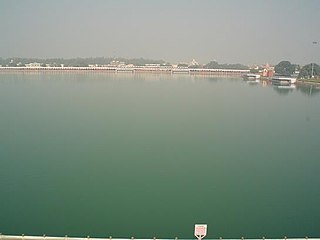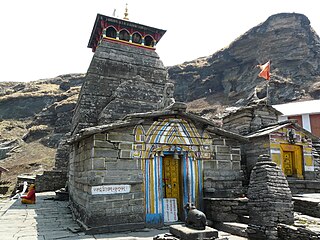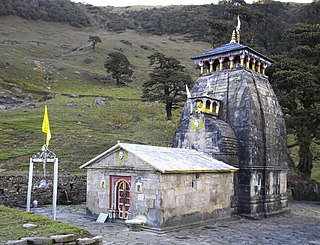This article relies largely or entirely on a single source .(July 2020) |
Kurukshetra Shiva Temple is a Hindu temple dedicated to the deity Shiva, located at Kurukshetra in Haryana, India. [1]
This article relies largely or entirely on a single source .(July 2020) |
Kurukshetra Shiva Temple is a Hindu temple dedicated to the deity Shiva, located at Kurukshetra in Haryana, India. [1]
It is one of the shrines of the Vaippu Sthalams sung by Tamil Saivite Nayanar Sundarar. [1]
The presiding deity in the garbhagriha, is represented by the lingam . In the rear side the sculpture of Kunti, who worshipped the deity is found. [1]
This place gave Bhagavad Gita. It has the longest tank in India. This place is also known as Dharmakshetra, Brahmashetra, Aryavardha and Uthiravedi. [1]
Kurukshetra can be reached from New Delhi by train or bus. [1]

Brahma Sarovar is an ancient water pool sacred to Hinduism in old Kurukshetra city, in the state of Haryana in North India,India. Hinduism lays emphasis on taking bath for internal and external purity. Most religious sites have water pools or sarovar in or near the Hindu temple and Sikh gurdwara. The Hindu genealogy registers at Kurukshetra, Haryana are kept here.

The Khatushyam Temple is a Hindu temple in the village of Khatushyamji, Rajasthan, India. It is a pilgrimage site for worshipping the deity Krishna and Barbarika who is often venerated as a Kuladevata. Devotees believe the temple houses the head of Barbarika or Katushyam, a legendary warrior who sacrifices his head upon the request of Krishna during the antebellum of the Kurukshetra War.

Parikrama or Pradakshina is clockwise circumambulation of sacred entities, and the path along which this is performed, as practiced in the Indian-origin religions - Hinduism, Buddhism, Sikhism and Jainism. In Buddhism, it refers only to the path along which this is performed. Typically, in Indic-religions the parikrama is done after completion of traditional worship and after paying homage to the deity. Parikrama must be done with dhyāna.

The ancient Sthaneshwar Mahadev Temple, dedicated to Lord Shiva is situated in old Kurukshetra city Kurukshetra district of Haryana, India. It was here that the Pandavas along with Krishna prayed to Shiva and received his blessings for victory in the battle of Mahabharata. The ninth Guru, Shri Tegh Bahadur stayed at a spot near the Sthaneshwar Tirtha that is marked by a gurdwara just besides this temple.

Kedarnath Temple is a Hindu temple (shrine) dedicated to the Hindu God Shiva. The temple is located on the Garhwal Himalayan range near the Mandakini river, in the state of Uttarakhand, India. Due to extreme weather conditions, the temple is open to the general public only between the months of April and November. During the winters, the vigraha (deity) from Kedarnath temple is carried down to Ukhimath where the deity is worshiped for the next six months. Kedarnath is seen as a homogenous form of Shiva, the 'Lord of Kedarkhand', the historical name of the region.

Tungnath (Sanskrit:तुंगनाथ) (IAST:tuņgnāth) is one of the highest Shiva temples in the world and is the highest of the five Panch Kedar temples located in the Rudraprayag district, in the Indian state of Uttarakhand. The Tungnath mountains form the Mandakini and Alaknanda river valleys. It is located at an altitude of 3,470 m (11,385 ft), and just below the peak of Chandrashila. and is the second in the pecking order of the Panch Kedars. It has a rich legend linked to the Pandavas, heroes of the Mahabharata epic.
In Hinduism, the yatra (pilgrimage) to the tirthas has special significance for earning the punya needed to attain the moksha (salvation) by performing the darśana, the parikrama (circumambulation), the yajna, the Dhyana, the puja (worship), the prarthana, the dakshina, the seva, the bhandara, etc. These sacred places are usually located on the banks of sacred water bodies, such as sacred rivers or their tributaries, the kundas, the ghats, or the stepwells, or the temple tanks.

The Paadal Petra Thalam are 275 temples that are revered in the verses of Saiva Nayanars in the 6th-9th century CE and are amongst the greatest Shiva temples of the continent. The Divya Desams by comparison are the 108 Vishnu temples glorified in the poems of the contemporary Vaishnava Alvars of Tamil Nadu, India

Anandavalleeswaram Sri Mahadevar Temple in Kollam city is one of the ancient Hindu temples in Kerala, India. Lord Siva and Goddess Anandavally are the main deities of the temple. According to folklore, sage Parashurama has installed the idol of Lord Shiva. The temple is a part of the 108 famous Shiva temples in Kerala. It is located at Anandavalleeswaram, a major neighborhood of Kollam city, that comes to the west side of Kollam Collectorate.

Yātrā, in Indian-origin religions, Hinduism, Buddhism, Jainism and Sikhism, generally means a pilgrimage to holy places such as confluences of sacred rivers, sacred mountains, places associated with Hindu epics such as the Mahabharata and Ramayana, and other sacred pilgrimage sites. Visiting a sacred place is believed by the pilgrim to purify the self and bring one closer to the divine. The journey itself is as important as the destination, and the hardships of travel serve as an act of devotion in themselves.

Kartikeya Temple in Pehowa township of the North Indian state of Haryana,India, is an ancient structure dating back to the 5th century B.C. Kartikeya is a popular Hindu deity in India and is worshiped across the length and breadth of the country. Like most Hindu deities, He is known by many other names, including Murugan, Senthil, Saravaṇa, Arumugam or Shanmukha, Kumāra, Guha, Skanda. The Kushanas, who governed from what is today Peshawar, and the Yaudheyas, a republican clan in the Punjab, stuck coins bearing the image of Skanda. The deity was venerated also by the Ikshvakus, an Andhra dynasty, and the Guptas.
Ivor Madom Parthasarathy Temple is a popular temple situated in Pampady village near Thiruvilwamala in Thrissur district, on the southern bank of Bharathappuzha, the second longest river of Kerala. The main deity of this temple is Lord Krishna as Parthasarathy, and there are sub-shrines for Ganapathi, Ayyappan, Shiva and Snake deities. The riverside near this temple is famous for performing rituals for dead ancestors. There is also a crematorium, jointly owned by Ivor Madom trust and Thiruvilwamala Grama Panchayat, near this temple.

Panch Kedar refers to five Hindu temples or holy places of the Shivaite sect dedicated to god Shiva. They are located in the Garhwal Himalayan region in Uttarakhand, India. They are the subject of many legends that directly link their creation to Pandavas, the heroes of the Hindu epic Mahabharata.

Madhyamaheshwar or Madmaheshwar is a Hindu temple dedicated to the Hindu god, Shiva, located in the Goundar village of Garhwal Himalayas in Uttarakhand, India. Situated at an elevation of 3,497 m (11,473.1 ft), It is one of the Panch Kedar pilgrimage circuit, comprising five Shiva temples in the Garhwal region. The other temples in the circuit include: Kedarnath, Tungnath and Rudranath to be visited before Madhyamaheshwar and Kalpeshwar to be visited after Madhyamaheshwar. The middle (madhya) or belly part or navel (nabhi) of Shiva, is worshipped at this temple, believed to be built by the Pandavas, the survivors of the Hindu epic Mahabharata.

Kalpeshwar is a Hindu temple dedicated to Shiva located at an elevation of 2,200 m (7,217.8 ft) in the picturesque Urgam valley in the Garhwal region of Uttarakhand state in India. The temple's ancient legend linked to the Pandavas, heroes of the epic Mahabharata, is the fifth temple of the Panch Kedar of Shiva's five anatomical divine forms; the other four temples in the order of their worship are Kedarnath, Rudranath, Tungnath and Madhyamaheshwar temples; all in the Kedar Khand region of the Garhwal Himalayas. Kalpeshwar is the only Panch Kedar temple accessible throughout the year. At this small stone temple, approached through a cave passage, the matted tress (jata) of Lord Shiva is worshipped. Hence, Lord Shiva is also called as Jatadhar or Jateshwar. Earlier it was approachable only by 12 km (7.5 mi) trek from the nearest road head of Helang on the Rishikesh-Badrinath road but now the road goes up to Devgram village from where the trek now is just 300 metres. This road is good for bikes or cars with good ground clearance as it is a half-paved road which may get damaged during monsoons. Small cars can be taken except in monsoons.

Doleshwor Mahadeva is a Hindu Temple of Lord Shiva located in the Suryabinayak Municipality, south eastern part of Bhaktapur District, Nepal, and is believed to be the head part of Kedarnath located in Uttarakhand, India.

Over the millennia of its development, Hinduism has adopted several iconic symbols, forming part of Hindu iconography, that are imbued with spiritual meaning based on either the scriptures or cultural traditions. The exact significance accorded to any of the icons varies with region, period and denomination of the followers. Over time some of the symbols, for instance the Swastika has come to have wider association while others like Aum are recognized as unique representations of Hinduism. Other aspects of Hindu iconography are covered by the terms murti, for icons and mudra for gestures and positions of the hands and body.
Kailasanathar Temple is a Hindu temple dedicated to the deity Shiva, located at Sembonarkovil in Nagapattinam district in Tamil Nadu, India.
Mathangeesvarar Temple is a Hindu temple dedicated to the deity Shiva, located at Nangur in Nagapattinam district, Tamil Nadu, India.
Srimoolanathar Temple is a Hindu temple dedicated to the deity Shiva, located at Keezhaiththanjavur in Nagapattinam district, Tamil Nadu, India.